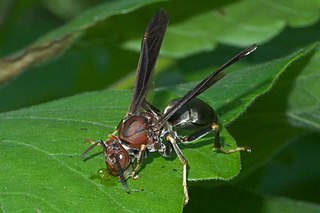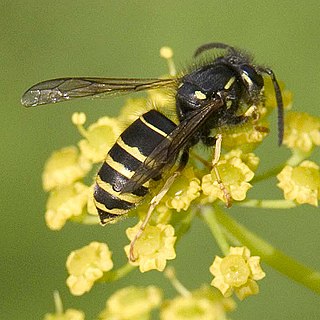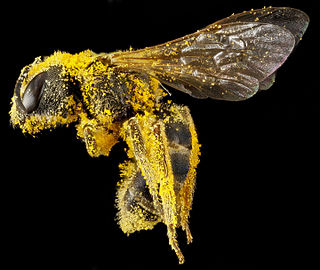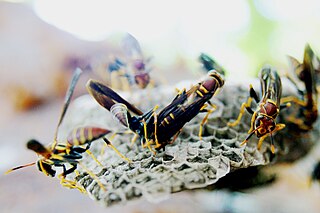
Vespula germanica, the European wasp, German wasp, or German yellowjacket, is a species of wasp found in much of the Northern Hemisphere, native to Europe, Northern Africa, and temperate Asia. It has spread and become well-established in many other places, including North America, South America, Australia, South Africa, and New Zealand. German wasps are part of the family Vespidae and are sometimes mistakenly referred to as paper wasps because they build grey paper nests, although strictly speaking, paper wasps are part of the subfamily Polistinae. In North America, they are also known as yellowjackets.

Eusociality, the highest level of organization of sociality, is defined by the following characteristics: cooperative brood care, overlapping generations within a colony of adults, and a division of labor into reproductive and non-reproductive groups. The division of labor creates specialized behavioral groups within an animal society which are sometimes referred to as 'castes'. Eusociality is distinguished from all other social systems because individuals of at least one caste usually lose the ability to perform at least one behavior characteristic of individuals in another caste. Eusocial colonies can be viewed as superorganisms.

Ropalidia marginata is an Old World species of paper wasp. It is primitively eusocial, not showing the same bias in brood care seen in other social insects with greater asymmetry in relatedness. The species employs a variety of colony founding strategies, sometimes with single founders and sometimes in groups of variable number. The queen does not use physical dominance to control workers; there is evidence of pheromones being used to suppress other female workers from overtaking queenship.

Polistes metricus is a wasp native to North America. In the United States, it ranges throughout the southern Midwest, the South, and as far northeast as New York, but has recently been spotted in southwest Ontario. A single female specimen has also been reported from Dryden, Maine. Polistes metricus is dark colored, with yellow tarsi and black tibia. Nests of Polistes metricus can be found attached to the sides of buildings, trees, and shrubbery.

Within the insect order Hymenoptera, the Halictinae are the largest, most diverse, and most recently diverged of the four halictid subfamilies. They comprise over 2400 bee species belonging to the five taxonomic tribes Augochlorini, Thrinchostomini, Caenohalictini, Sphecodini, and Halictini, which some entomologists alternatively organize into the two tribes Augochlorini and Halictini.

Vespula acadica, also known as the Forest Yellowjacket, is a North American species of eusocial wasp which is part of the "rufa" group within the genus Vespula. It is a black and yellow wasp that is found in arboreal areas and builds its nests most often in decaying vegetation like logs, but has occasionally been found to build aerial nests. Due to its preference for forests V. acadica does not normally come into contact with humans; however, when colonies are disturbed, workers of this yellowjacket may be quite aggressive and persistent and sting repeatedly.

Halictus ligatus is a species of sweat bee from the family Halictidae, among the species that mine or burrow into the ground to create their nests. H. ligatus, like Lasioglossum zephyrus, is a primitively eusocial bee species, in which aggression is one of the most influential behaviors for establishing hierarchy within the colony, and H. ligatus exhibits both reproductive division of labor and overlapping generations.
Eusocial insects have developed from their organization an ability to recognize one another within their society. This recognition of others, from recognizing individuals to groups, is an indication of society, and creates an identity colony wide for each insect.
Apoica flavissima is a paper wasp found primarily in South America. The species is distinguishable by its light coloring, unique single comb nests, and nocturnal nature. A notable feature of this species is the size dimorphism between queens and workers. Unlike most Vespidae wasps, Apocia flavissima queens are smaller than their worker counterparts which results in unique intraspecies relationships.

Polistes instabilis, or unstable paper wasp is a type of paper wasp, is a neotropical, eusocial wasp that can be found in tropical and subtropical areas such as Central America and South America. It can be easily identified with its characteristic yellow, brown, and reddish markings, and it builds nests made from chewing plant fibers and making them into paper.

Polybia occidentalis, commonly known as camoati, is a swarm-founding advanced eusocial wasp. Swarm-founding means that a swarm of these wasps find a nesting site and build the nest together. This species can be found in Central and South America. P. occidentalis preys on nectar, insects, and carbohydrate sources, while birds and ants prey on and parasitize them. P. occidentalis workers bite each other to communicate the time to start working.

Synoeca cyanea, commonly known as the marimbondo-tatu in Brazil, is a swarm-founding eusocial wasp. Native to Brazil and Argentina, S. cyanea is one of the largest and most aggressive species of social wasps and is feared in many rural areas. It begins its colony cycle in the early spring and continues until nest abandonment. Throughout its life, S. cyanea forage sugary substances and animal carcasses for food and wood pulp for its nest. S. cyanea is also known for its strong venom, which is enough to cause haemolytic activity.
Protonectarina sylveirae, commonly referred to as the Brazilian wasp, is a neotropical swarm-founding wasp species that ranges widely across South America. This species relies heavily on the consumption of animal protein rather than nectar. P. sylveirae preys heavily on agricultural pests to coffee crops, keeping pest populations low.

Belonogaster petiolata is a species of primitively eusocial wasp that dwells in southern Africa, in temperate or subhumid climate zones. This wasp species has a strong presence in South Africa and has also been seen in northern Johannesburg. Many colonies can be found in caves. The Sterkfontein Caves in South Africa, for example, contain large populations of B. petiolata.

Polistes biglumis is a species of social wasp within Polistes, the most common genus of paper wasp. It is distinguished mainly by its tendency to reside in montane climates in meadows or alpine areas. Selection pressure from the wasp's environment has led to several idiosyncrasies of its behavior and lifecycle with respect to its relative species in the genus Polistes. It alone among paper wasps is often polyandrous. In addition, it has a truncated nesting season that gives rise to unique competitive dynamics among females of the species. P. biglumis wasps use an odor-based recognition system that is the basis for all wasp-to-wasp interaction of the species. The wasp's lifecycle is highly intertwined with that of Polistes atrimandibularis, an obligate social parasite wasp that frequently invades the combs of P. biglumis wasps.
Protopolybia exigua is a species of vespid wasp found in South America and Southern Brazil. These neotropical wasps, of the tribe Epiponini, form large colonies with multiple queens per colony. P. exigua are small wasps that find nourishment from nectar and prey on arthropods. Their nests are disc-shaped and hang from the undersides of leaves and tree branches. This particular species of wasp can be hard to study because they frequently abandon their nests. P. exigua continuously seek refuge from phorid fly attacks and thus often flee infested nests to build new ones. The wasps' most common predators are ants and the parasitoid phorid flies from the Phoridae family.

Polybia sericea is a social, tropical wasp of the family Vespidae that can be found in South America. It founds its colonies by swarming migrations, and feeds on nectar and arthropods.

Ropalidia romandi, also known as the yellow brown paper wasp or the yellow paper wasp. is a species of paper wasp found in Northern and Eastern Australia. R. romandi is a swarm-founding wasp, and manages perennial nests. Its nests are known as 'paper bag nests' and have different architectural structures, depending on the substrates from which they are built. The specific name honors Gustave, baron de Romand, a prominent French political figure and amateur entomologist.
Parachartergus fraternus is a neotropical, swarm founding, polistine wasp species that is distributed throughout Central and South America. They live in nests in second growth tropical dry forests, near pasture fields, roadside areas, and urban areas as well. These wasps eat insects, such as caterpillars of Lepidoptera. They also drink nectar, honeydew, and water. The workers capture their prey during foraging. They also use venom to paralyze their prey in order to consume it later. P. fraternus wasps are not very aggressive and they do not attack when the nest is approached.

Nest usurpation is when the queen of one species of eusocial insects takes over the colony of another species.